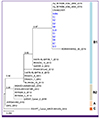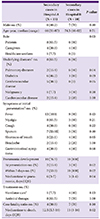Abstract
Background
Materials and Methods
Results
Conclusion
Figures and Tables
Figure 1
Epidemic curve of all cases with Middle East respiratory syndrome-coronavirus (MERS-CoV) infection linked to the index case in Daejeon, South Korea. All cases with MERS-CoV infection are plotted by the date of symptom onset, according to the hospital. The implementation of infection control measures is also shown in the graph.

Figure 2
Transmission map of outbreak of Middle East respiratory syndrome-coronavirus infection in Daejeon and chest CT scans of the index case.

Figure 3
Distributions of incubation periods of cases with Middle East respiratory syndrome-coronavirus infection in two hospitals in Daejeon. The fitted distributions of incubation periods of Hospital A (blue line) and B (red line) are plotted against the empirical cumulative density function of observed incubation periods (midpoint of exposure to symptom onset) (black line). The 95% confidence intervals for the medians of these fitted distributions are also plotted. Bootstrap estimates are shown in grey shading.

Figure 4
Phylogenetic analysis of S2 fragment sequences of Middle East respiratory syndrome-coronavirus (MERS-CoV) from 11 cases from the Daejeon cluster. The partial S2 fragment sequences of MERS-CoV spike genes were obtained from the index case (Index), 4 secondary cases (A1, A2, A3, A8) from the Hospital A cluster and 4 secondary cases (B1, B2, B6, B7) from the Hospital B cluster. The S2 fragment sequences isolated from two tertiary cases (A14, B11) were also analyzed. The new 2 sequences of spike genes identified in this study are highlighted in blue, and compared with the previously published 20 MERS-CoV genomes (Supplementary Table 2). Values on nodes correspond to posterior probability values obtained from the approximate likelihood ratio test based on a Shimodaira-Hasegawa-like procedure.

Table 1
Demographic and clinical characteristics of cases in the Daejeon cluster of Middle East respiratory syndrome-coronavirus infection, 2015

IQR, interquartile range.
aTwo cases had chronic liver disease and one had chronic kidney disease. The index case had received total colectomy for familial adenomatous polyposis. Pulmonary diseases included chronic obstructive pulmonary disease in four cases, lung cancer in two, pulmonary tuberculosis in one, and chronic pneumonia in one.
bFour cases (A8, A9, A13, and A15) had only mild symptoms and fever.
cSix cases died of respiratory failure before receiving ventilator care. One tertiary case (A15) received a ventilator care with an extracorporeal membrane oxygenation therapy.




 PDF
PDF ePub
ePub Citation
Citation Print
Print



 XML Download
XML Download